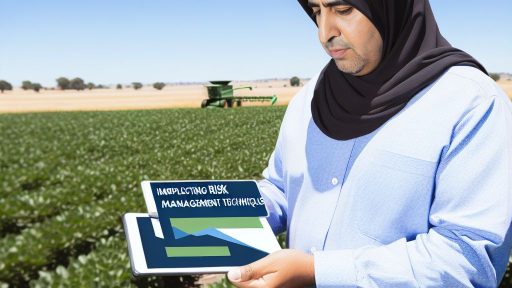Introduction to Soil Health and Its Importance in Sustainable Farming
Soil health is vital for sustainable agriculture.
Healthy soil supports plant growth and agricultural productivity.
Moreover, it enhances environmental quality and biodiversity.
Understanding soil health requires considering several factors.
These factors include soil structure, composition, and biological activity.
The Role of Soil in Agricultural Ecosystems
Soil acts as a reservoir for water and nutrients.
It plays a key role in regulating the climate.
Furthermore, soil supports a diverse community of organisms.
These organisms contribute to nutrient cycling and decomposition.
As a result, healthy soil fosters resilient ecosystems.
The Link Between Soil Health and Crop Yield
Healthy soil directly influences crop yield and quality.
Rich, organic matter increases soil fertility and moisture retention.
Better soil health leads to more robust crops.
Consequently, farmers experience improved profits and sustainability.
Impacts of Poor Soil Health
Poor soil health can lead to decreased agricultural productivity.
Transform Your Agribusiness
Unlock your farm's potential with expert advice tailored to your needs. Get actionable steps that drive real results.
Get StartedIt also increases vulnerability to pests and diseases.
Additionally, soil erosion and nutrient depletion become major issues.
Ultimately, this results in economic losses for farmers.
Importance of Soil Health Management
Soil health management is essential for sustainable farming practices.
It promotes balanced ecosystem functions and agricultural resilience.
Practicing soil health management helps mitigate environmental challenges.
Farmers play a crucial role in protecting soil resources.
By implementing effective practices, they ensure future productivity.
Key Indicators of Soil Health
Understanding Soil Quality Metrics
Soil health is essential for sustainable farming.
It reflects the soil’s capacity to function effectively.
Healthy soil supports plant growth and ecosystem balance.
To assess soil health, farmers use various indicators.
Physical Indicators
Soil texture plays a crucial role in drainage and aeration.
Good soil structure improves root penetration and water retention.
Soil compaction affects the movement of water and roots.
Additionally, the presence of organic matter indicates soil quality.
- Soil texture influences nutrient availability.
- Soil structure improves resilience against erosion.
- Organic matter enhances microbial activity and nutrient cycling.
Chemical Indicators
Soil pH is vital for nutrient availability to plants.
Testing for essential nutrients reveals soil fertility levels.
The balance of macronutrients and micronutrients is important.
Healthy soil contains adequate levels of calcium, magnesium, and potassium.
- Acidic soils may limit nutrient uptake.
- Over-fertilization can lead to nutrient runoff.
- Understanding nutrient levels helps in precision farming.
Biological Indicators
Microbial biomass indicates the biological activity of the soil.
Diversity of soil organisms supports nutrient cycling.
Earthworm populations are a sign of soil health.
Soil respiration rates reflect microbial activity levels.
Showcase Your Farming Business
Publish your professional farming services profile on our blog for a one-time fee of $200 and reach a dedicated audience of farmers and agribusiness owners.
Publish Your Profile- Higher microbial activity improves soil fertility.
- Healthy populations of earthworms aerate and enrich the soil.
- Microbial diversity enhances ecosystem resilience.
Integrating Soil Health Indicators
Farmers should consider all indicators holistically.
Each aspect of soil health affects farming outcomes.
Regular monitoring allows for timely interventions.
Improving soil health leads to sustainable agricultural practices.
Ultimately, healthy soil contributes to food security.
Practices to Enhance Soil Organic Matter
Composting
Composting enriches the soil by recycling organic materials.
This process involves collecting food scraps, yard waste, and other biodegradable materials.
As materials decompose, they create nutrient-rich compost.
Farmers can use compost to improve soil structure and fertility.
This practice increases the soil’s ability to retain moisture.
Additionally, it encourages beneficial microorganisms in the soil.
To start composting, maintain a balance of green and brown materials.
Green materials include grass clippings and fruit scraps.
Brown materials consist of dry leaves and cardboard.
Turning the compost pile regularly aerates it and accelerates decomposition.
This results in high-quality compost in a shorter time.
Cover Crops
Cover crops are plants grown primarily to benefit the soil.
They cover the ground during off-seasons when the soil would otherwise be bare.
This practice helps prevent soil erosion caused by wind and rain.
Furthermore, cover crops improve soil structure and increase organic matter.
Leguminous cover crops, such as clover or vetch, fix nitrogen in the soil.
This added nitrogen supports healthy crop growth for the following season.
Managing cover crops can lead to better yields and reduced need for fertilizers.
Farmers can terminate cover crops by mowing or tilling before planting main crops.
Incorporating cover crops into a farming system enhances productivity sustainably.
You Might Also Like: Improving Crop Distribution with Effective Supply Chain Management
The Role of Crop Rotation in Soil Health Management
Defining Crop Rotation
Crop rotation involves alternating the types of crops grown in a particular area.
This practice breaks pest and disease cycles.
It also enhances soil fertility by varying nutrient demands.
Benefits of Crop Rotation
Crop rotation improves soil structure and organic matter content.
This helps increase water retention in the soil.
Moreover, it reduces soil erosion caused by continuous cropping.
Impact on Soil Health
Diverse root structures from different crops help aerate the soil.
This aeration boosts microbial activity and nutrient uptake.
In addition, rotational planting lowers the likelihood of soil compaction.
Common Crop Rotation Systems
One popular system includes alternating grains and legumes.
Legumes add nitrogen back into the soil, improving fertility.
Another effective system is the three-crop rotation of corn, soybeans, and wheat.
Implementing Crop Rotation
Farmers should plan rotations based on local conditions and specific crops.
They can consult agricultural extension services for tailored advice.
Showcase Your Farming Business
Publish your professional farming services profile on our blog for a one-time fee of $200 and reach a dedicated audience of farmers and agribusiness owners.
Publish Your ProfileFinally, keeping records of crop performance enhances future planning.
Exploring Sustainable Practices
Adopting crop rotation can yield significant benefits for soil health.
Farmers should explore sustainable practices to improve their land.
Integrating crop rotation with other sustainable methods can enhance results.
You Might Also Like: Cost-Effective Pest Control Solutions For Farmers
Minimizing Soil Disturbance
The Benefits of No-Till Farming
No-till farming significantly reduces soil erosion.
This method preserves soil structure and improves water retention.
As a result, it enhances soil health and fertility over time.
Moreover, no-till farming decreases the need for chemical inputs.
This leads to healthier ecosystems with more biodiversity.
Farmers can also reduce fuel and labor costs through this practice.
Research shows that no-till farming can increase crop yields.
It allows for the buildup of organic matter in the soil.
The Impact of Reduced-Till Farming
Reduced-till farming involves minimal soil disturbance.
Farmers accomplish this by using specialized equipment.
This practice retains more moisture in the soil compared to traditional methods.
Consequently, it promotes healthier root development for crops.
Moreover, reduced-till farming aids in controlling weeds naturally.
This minimizes the reliance on herbicides and other chemical treatments.
Farmers also find that reduced-till methods can save time.
They spend less time preparing the field for planting.
Comparative Advantages
Both no-till and reduced-till practices provide numerous benefits.
They contribute to improved soil health and reduced environmental impact.
Farmers practicing these methods often report increased resilience.
Healthy soils can better withstand extreme weather conditions.
Additionally, these methods enhance carbon sequestration in the soil.
This further combats climate change by reducing greenhouse gases.
Minimizing soil disturbance supports sustainable agriculture.
It ensures the land remains productive for future generations.
Learn More: Leveraging Technology To Improve Crop Yields

Utilizing Soil Amendments: Gypsum, Lime, and Organic Fertilizers
Understanding Soil Amendments
Sole amendments improve soil structure and fertility.
They correct soil deficiencies and enhance nutrient availability.
Common amendments include gypsum, lime, and organic fertilizers.
Gypsum and Its Benefits
Gypsum is primarily used to improve clay soil.
It helps reduce soil compaction and enhances drainage.
Moreover, gypsum adds calcium without altering pH levels.
Additionally, it can help reduce erosion on sloped lands.
Lime’s Role in Soil Health
Lime is essential for adjusting soil pH levels.
Applying lime can transform acidic soils into more neutral ones.
This adjustment allows crops to access essential nutrients.
Showcase Your Farming Business
Publish your professional farming services profile on our blog for a one-time fee of $200 and reach a dedicated audience of farmers and agribusiness owners.
Publish Your ProfileFurthermore, lime promotes beneficial microbial activity in the soil.
Organic Fertilizers as Soil Amendments
Organic fertilizers are derived from natural sources.
They enrich the soil with nutrients and improve microbial health.
Common organic fertilizers include compost, manure, and bone meal.
These materials enhance soil structure and moisture retention.
Additionally, they contribute to long-term soil fertility.
Best Practices for Applying Amendments
Test your soil before applying any amendments.
This ensures you meet specific nutrient needs effectively.
Evenly distribute amendments across the soil surface.
Incorporating them into the soil enhances their effectiveness.
Finally, monitor soil health regularly for optimal results.
Gain More Insights: Leveraging Technology for Farm Supply Chain Optimization
Integrating Livestock in Crop Systems
Importance of Manure Management
Manure management is crucial for enhancing soil fertility.
It provides essential nutrients to crops, improving yields over time.
Moreover, proper manure management aids in sustainability.
It reduces waste and promotes recycling of nutrients on the farm.
Types of Manure and Their Benefits
Different types of manure offer unique advantages.
- Cattle manure is rich in nitrogen, phosphorus, and potassium.
- Poultry manure has a higher nutrient concentration than other types.
- Swine manure is beneficial for its organic matter content.
Choosing the right type of manure can boost soil health effectively.
Best Practices for Manure Application
Applying manure at the right time is vital for effectiveness.
Farmers should consider applying manure before planting.
Additionally, one should test soil nutrient levels regularly.
This ensures the nutrients meet crop needs without over-application.
Employing techniques like banding can enhance nutrient uptake.
Environmental Considerations
Managing manure also helps protect the environment.
Adequate storage facilities prevent nutrient runoff into waterways.
Farmers should employ buffer zones to filter runoff effectively.
Regular training on manure management is essential for best practices.
Integrating Livestock into Crop Rotation
Incorporating livestock enhances soil microbial activity.
This integration also improves soil structure and fertility.
Additionally, rotating crops and livestock diversifies farm output.
This practice minimizes pest problems and reduces weeds.
Case Studies of Successful Integration
Several farms successfully integrate livestock and cropping systems.
Green Valley Farm uses cattle to graze cover crops.
This practice increases organic matter and mitigates erosion.
Sunny Fields Homestead enhances vegetable yields through poultry manure.
The result is improved soil health and reduced fertilizer costs.
Monitoring and Assessing Soil Health Over Time
Importance of Soil Health Assessment
Regular assessment helps identify changes in soil condition.
It ensures that farming practices support soil vitality.
This process ultimately enhances crop productivity.
Tools for Soil Health Monitoring
Various tools aid in monitoring soil health effectively.
Showcase Your Farming Business
Publish your professional farming services profile on our blog for a one-time fee of $200 and reach a dedicated audience of farmers and agribusiness owners.
Publish Your Profile- Soil test kits measure essential nutrient levels.
- pH meters assess soil acidity.
- Moisture sensors provide irrigation insights.
Techniques for Assessing Soil Health
Employ techniques to evaluate soil structure and composition.
Visual inspection reveals soil texture and color variations.
Core sampling offers insights into soil density.
Also, microbial analysis helps in understanding soil biota.
Establishing Baselines
Establish baseline measurements for effective monitoring.
This step allows farmers to track changes over time.
Baseline data informs adjustment of management practices.
Using Data for Informed Decision Making
Analyze collected data to guide soil management strategies.
Comparing annual results helps identify trends.
Informed decisions can lead to enhanced soil health.
Long-Term Monitoring Strategies
Implement long-term monitoring plans for sustained results.
Regular assessments should become part of standard practices.
Collaborate with agronomists for expert guidance.




